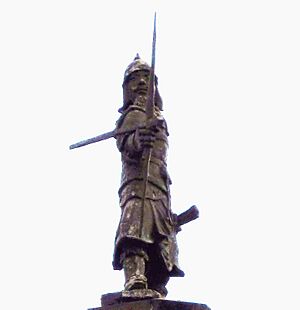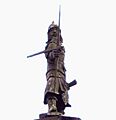An Dương Vương facts for kids
Quick facts for kids An Dương Vương安陽王 |
|||||
|---|---|---|---|---|---|

King An Dương Vương statue at Cổ Loa Temple, Đông Anh, Hanoi
|
|||||
| King of Âu Lạc | |||||
| Reign | 257–179 BC | ||||
| Predecessor | Hùng Duệ Vương of Văn Lang | ||||
| Successor | Dynasty collapsed Triệu Đà of Nanyue |
||||
| Born | Unknown (possibly 300 BC) | ||||
| Died | about 179 BC (aged c. 121) | ||||
| Issue | Mỵ Châu | ||||
|
|||||
| Father | Thục Chế 蜀制 (in Tày people's legend) | ||||
| An Dương Vương | |
| Vietnamese alphabet | An Dương Vương |
|---|---|
| Chữ Hán | 安陽王 |
| Birth name | |
| Vietnamese alphabet | Thục Phán |
|---|---|
| Chữ Hán | 蜀泮 |
An Dương Vương, whose real name was Thục Phán, was a very important king in ancient Vietnam. He was the first and only ruler of the kingdom of Âu Lạc. This ancient state was located in the area we now call the Red River Delta. As a strong leader of the Âu Việt tribes, he defeated the last Hùng king of the state of Văn Lang. He then united his people, the Âu Việt, with the people of Văn Lang, known as the Lạc Việt. An Dương Vương ruled until he was defeated in a war with Nanyue forces in 179 BCE. He then took his own life.
Contents
Biography
How Âu Lạc Began
An Dương Vương came from a region to the north of Văn Lang. He was a powerful leader of the Âu Việt tribes. He managed to defeat the last Hùng king, who ruled the state of Văn Lang. After his victory, he brought together the Âu Việt people and the Lạc Việt people from Văn Lang. This union created a new, stronger kingdom called Âu Lạc. He declared himself King An Dương and established his rule around 257 BCE.
Building Cổ Loa Citadel
After becoming king, An Dương Vương ordered the building of a strong fortress. This fortress was in a place called Tây Vu and became known as Cổ Loa Citadel. It was designed in a unique spiral shape, like a snail's shell. In fact, its name, Cổ Loa, means "old snail."
There's a famous legend about how Cổ Loa was built. It says that spirits kept undoing the work each night. King An Dương Vương prayed for help. Suddenly, a giant golden turtle appeared from the water! The turtle helped protect the King and the workers until the citadel was finished. Before leaving, the golden turtle gave the King one of its claws. It told him to use it to make a special crossbow. The turtle promised that with this crossbow, the King would be unbeatable. A skilled craftsman named Cao Lỗ made the crossbow. It was called the "Saintly Crossbow of the Supernaturally Luminous Golden Claw." It was said that one shot from this crossbow could defeat many enemies.
War with Nanyue
Around 204 BCE, a new kingdom called Nanyue was formed to the north, led by Zhao Tuo. At first, Âu Lạc and Nanyue had a peaceful relationship. However, Zhao Tuo eventually decided to attack Âu Lạc.
The first attacks by Zhao Tuo were not successful. The Golden Turtle's crossbow made King An Dương Vương's army very strong. Seeing that he couldn't win by force, Zhao Tuo tried a different plan. He asked for a truce and sent his son, Zhong Shi, to serve King An Dương.
While at King An Dương's court, Zhong Shi and the King's daughter, Mỵ Châu, fell in love and got married. Zhong Shi lived with Mỵ Châu's family, which was the custom at the time. During this time, Zhong Shi secretly learned about King An Dương's military plans and the secret of the powerful crossbow. Meanwhile, King An Dương Vương treated Cao Lỗ, the crossbow maker, poorly, and Cao Lỗ left.
Zhong Shi tricked Mỵ Châu into showing him the special crossbow. He secretly swapped its magical trigger with a fake one, making it useless. Then, he asked to return to his father. As soon as Zhong Shi left, Zhao Tuo launched another attack on Âu Lạc. This time, King An Dương's army was defeated because the special crossbow no longer worked. History says that the Golden Turtle appeared to the King and told him about his daughter's mistake. The King was very sad and took his daughter's life before disappearing into the water.
Legacy
Historians believe that the main events of An Dương Vương's time are based on real history. The capital city of King An Dương, Cổ Loa, was the first important political center of Vietnamese civilization before Chinese rule. The site of Cổ Loa has large outer walls and an inner fortress. It was also protected by rivers and lakes, which helped with defense and travel. Cổ Loa was a busy place, possibly home to 5,000 to 10,000 people.
See also
- Đông Sơn culture
- History of Vietnam
- Hồng Bàng dynasty
- Lạc Việt
- Âu Việt
- Nam Việt
- Triệu dynasty
- Triệu Đà
- Phiên Ngung
- Trọng Thuỷ
- Âu Lạc
- Cổ Loa Citadel
- Tây Vu Vương
- Bách Việt
Images for kids




